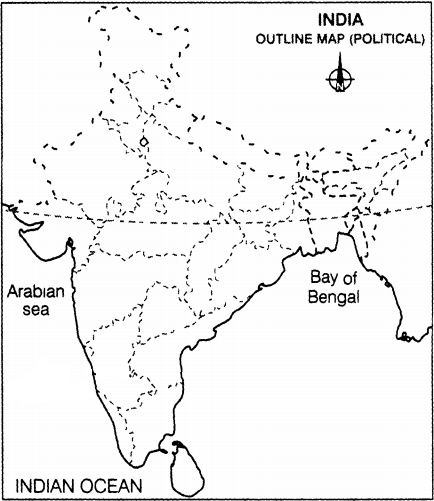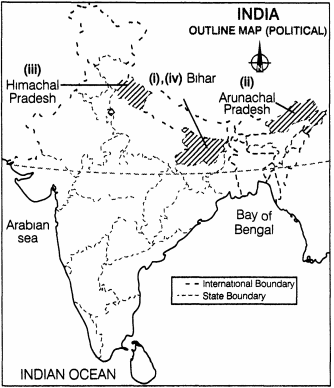Geography Class 12 Population Chapter 1 Important Questions. myCBSEguide has just released Chapter Wise Question Answers for class 12 Geography. There chapter wise Practice Questions with complete solutions are available for download in myCBSEguide website and mobile app. These Questions with solution are prepared by our team of expert teachers who are teaching grade in CBSE schools for years. There are around 4-5 set of solved Geography Extra Questions from each and every chapter. The students will not miss any concept in these Chapter wise question that are specially designed to tackle Board Exam. We have taken care of every single concept given in CBSE Class 12 Geography syllabus and questions are framed as per the latest marking scheme and blue print issued by CBSE for class 12.
CBSE Class 12 Geography Practice Test
Population: Distribution, Density, Growth and Composition Class 12
India Population
-
Which parts of India have a low degree of urbanization?
-
Name the Union Territory of Indian having lowest density of population as per 2011 census.
-
Explain the position of India in the world in terms of its total population and density of population.
-
Name the states which have less population in comparison to the extent of their land area.
-
Analyse the linguistic composition of India.
-
”Socio-economic factors influence high density of population”. Give reasons.
-
Which are the three groups of Indian population according to their economic status? Explain the main characteristics of each group.
-
India is a secular country. Substantiate the statement with statistical facts.
-
Distinguish between the rural population and urban population.
-
Locate and label the following on the given political outline map of India with appropriate symbols.
- The state having the highest density of population.
- The state with lowest density of population.
- The state with highest percentage of rural population.
- The state having the lowest literacy rate in India.

India Population
Answer
- India has a low degree of urbanization in:
- Non irrigated western Rajasthan
- Remote and hilly areas and tribal areas of North East
- Flood-prone areas
- Hilly and Forested areas of Central India
- As per census 2011, the least densely populated Union Territory of India is Andaman and Nicobar Islands with a density of 46 persons/sq km.
- In terms of total population India has second position after China. But in terms of density of population, India was third after Japan and Bangladesh in 2001 and it is second in 2011 after Bangladesh.
- States with lowest density of population are Arunachal Pradesh (17 persons per sq km), Mizoram, (52 persons per sq km and Sikkim (86 persons per sq km). The union territory with lowest population density is Andaman and Nicobar Island with 46 persons per sq km.
- India is a land of linguistic diversity. According to Grierson (Linguistic Survey of India, 1903 – 1928) there were 179 languages and as many as 544 dialects in the country.
- In the context of modern India, there are about 18 scheduled languages and a number of non- scheduled languages.
- Among the scheduled languages, the speakers of Hindi have the highest percentage (40.42).
- The smallest language groups are Kashmiri and Sanskrit speakers (0.01 per cent each).
- It is absolutely right to say that socio-economic factors influence high density of population:
- Evolution of settled agriculture and agricultural development.
- Pattern of human settlement.
- Development of transport network.
- Urbanisation and industrilisation before.
- River plains and coastal areas; urban centres/industrial areas.
- On the basis of economic status, India’s population is divided into the following three categories:
- Main Workers: A person who works for at least 183 days in a year. They are the main contributors to a nation’s GDP.
- Marginal Workers: A person who works for less than 183 days in a year. They are mostly engaged in the agricultural sector.
- Non-Worker: A person who does not work for his livelihood. They are dependent on the working population for their needs.
- It is absolutely right that India is a secular country where people following different religions live together with unity. It can be understood by looking at spatial distribution of religious communities in the country. It shows that certain states and districts have large numerical strength of one religion, while the same may be very negligibly represented in other states.
- Hindus: They are ranging from 70-80 per cent. Exceptions include the districts of states along Indo-Bangladesh border, Indo-Pak border, Jammu & Kashmir, hill states of North-east & in scattered areas of Deccan Plateau & Ganga Plain.
- Muslims: It is the largest religious minority. They are concentrated in Jammu & Kashmir, West Bengal, Kerala, UP, Delhi & Lakshadweep. They form majority in Kashmir valley & Lakshadweep.
- Christians: They are concentrated along the Western coast of Goa, Kerala, Meghalaya, Mizoram, Nagaland, Chotanagpur & Hills of Manipur.
- Sikhs: They are concentrated in small areas of the country particularly in states of Punjab, Haryana and Delhi.
- Jains and Buddhists: They are the smallest religious groups. Jains have major concentration in the urban areas of Rajasthan, Gujarat and Maharashtra. Buddhists are concentrated in Maharashtra, Sikkim, Arunachal Pradesh, Ladakh in Jammu & Kashmir and Tripura.
- Zoroastrians: They have tribal and other indigenous faiths and beliefs. They are concentrated in small pockets scattered throughout the country.
-
Rural Population Urban Population Part of the population living in the villages is known as rural population. Part of the population living in towns and cities is known as urban population. Rural population is mostly engaged in agricultural and other activities. Urban population is engaged in secondary and tertiary occupations. Above 72% of the total population in India is living in rural areas. About 28% of the total population live in urban areas. Population growth is lower in rural population. Population growth is higher in the urban population due to immigration. The rural population differs from urban in their way of life, occupational structure, attitudes and deeds. The urban population enjoys several socio-economic facilities such as improved transport and communication, health, etc. Rural folks are simple and close and deep relation with each other. Urban life is fast and social relation is formal. The rural population has no problems with housing and transportation but some villages face the problem of drinking water. The urban population faces many problems in housing, health, drinking water, etc. 
Chapter Wise Extra Questions for Class 12 Geography
Fundamentals of Human Geography Chapters
- Human Geography Nature and Scope
- The World Population Distribution, Density and Growth
- Population Composition
- Human Development
- Primary Activities
- Secondary Activities
- Tertiary and Quaternary Activities
- Transport and Communication
- International Trade
- Human Settlements
India – People and Economy
- Population: Distribution, Density, Growth and Composition
- Migration: Types, Causes and Consequences
- Human Development
- Human Settlements
- Land Resources and Agriculture
- Water Resources
- Mineral and Energy Resources
- Manufacturing Industries
- Planning and Sustainable Development in Indian Context
- Transport and Communication
- International Trade
- Geographical Perspective on Selected Issues and Problems

Test Generator
Create question paper PDF and online tests with your own name & logo in minutes.
Create Now
Learn8 App
Practice unlimited questions for Entrance tests & government job exams at ₹99 only
Install Now